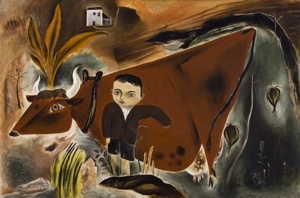Yasuo Kuniyoshi ( 1889 - 1953)
Little Joe with Cow
1923
Oil on canvas
Art © Estate of Yasuo Kuniyoshi/Licensed by VAGA, New York, NY. Photography by Edward C. Robison III.
Modern Art Gallery
Description of Little Joe with Cow
NARRATOR: The painting that you are in front of is entitled Little Joe with Cow and was made by the artist Yasuo Kuniyoshi in 1923 using oil on canvas. It is 28 inches tall by 42 inches wide and depicts an outdoor scene with a young boy and a cow in an area with vegetation. The painting is displayed in a white-washed, beveled wooden frame with a few delicate decorative elements lining the center. The framed painting spans roughly from waist height to slightly above the top of one’s head.
In the foreground of the painting is a boy and a large brown cow [cow mooing]. The cow is a mix of curved and angular shapes with the straight line of its back running across from the center of the painting to its tail in the upper right which forms a sharp angle that extends with a straight line to its foot. The tail is long, black, and finely textured with hair that curls down in front of the cow’s leg. Below the cow’s tail is a small pointed hoof on the bottom of its triangular leg. Behind the leg is a white and swollen udder with gray color, white spots and four teats. The belly of the cow is plump and curved with a curved line running to the cow’s angular head which is about halfway up the painting on the left side. Dark brown hair that looks like bangs rests on the cow’s forehead and two curved white horns protrude from the sides of its head. A single wooden yoke rests on its shoulders and one of the cow’s large light brown eyes peers out at us the viewers.
Standing directly in front of the cow is the young boy, Little Joe. He faces us and leans on the cow with an extended left arm. Little Joe is wearing a white shirt mostly covered by a dark brown blazer and knee-length black shorts. We cannot see his ankles and feet which appear to be sunken into the earth and covered by a mix of grasses and other vegetation. Little Joe has a square-shaped face and short black hair. His facial features are small and angular, and his brown eyes peer out at us the viewers, although Little Joe’s eyes are smaller and less defined than the cow’s large eye.
Surrounding Little Joe and the cow is a mix of vegetation including ferns, reeds, and grasses. The plants line the foreground of the painting in front of the boy and cow along with a large dark mass that appears to be a rock, branch, or mud. Plants also flank the cow’s body on the right side, including a larger plant with drooping seed pods. A dark ridge of the landscape in the background extends from the right edge of the painting upwards and curves to the left, complementing the shape of the cow’s rear and back. Two plants grow behind the cow’s head on the left side of the painting, including a larger rust-colored botanical that almost appears to be sprouting from the cow’s head, due to the flatness of the perspective of the painting.
Left of center on the top of the painting in the background is a small, modest two-story house. The house includes a vertical white rectangular shape with a flat black roof with another shorter horizontal rectangle attached to its right. Connecting the two sections is a triangular shape that looks like a lean-to roof. The house lacks ornamentation and has a front door and four windows – two windows on the second floor of the main building and two on the smaller horizontal section attached. One window on the top floor of the main building has curtains while the rest are bare. A small path leads from the front door across the front of the house to the right and up and behind into a darker area that resembles hills or mountains.
The overall color palette of the artwork is earth tones including shades of browns, ochres, blacks and rusted oranges. A few yellow-green grasses grow in the foreground on the left side of the painting, which contrasts with the right side which is overall darker in color with dark browns and grays, giving the appearance of water or shadows.
[End of Stop]



